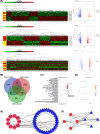Identification of potential diagnostic and prognostic biomarkers for LUAD based on TCGA and GEO databases
- PMID: 34017995
- PMCID: PMC8182989
- DOI: 10.1042/BSR20204370
Identification of potential diagnostic and prognostic biomarkers for LUAD based on TCGA and GEO databases
Abstract
Accumulating evidence has demonstrated that gene alterations play a crucial role in LUAD development, progression, and prognosis. The present study aimed to identify the hub genes associated with LUAD. In the present study, we used TCGA database to screen the hub genes. Then, we validated the results by GEO datasets. Finally, we used cBioPortal, UALCAN, qRT-PCR, HPA database, TCGA database, and Kaplan-Meier plotter database to estimate the gene mutation, gene transcription, protein expression, clinical features of hub genes in patients with LUAD. A total of 5930 DEGs were screened out in TCGA database. Enrichment analysis revealed that DEGs were involved in the transcriptional misregulation in cancer, viral carcinogenesis, cAMP signaling pathway, calcium signaling pathway, and ECM-receptor interaction. The combining results of MCODE and CytoHubba showed that ADCY8, ADRB2, CALCA, GCG, GNGT1, and NPSR1 were hub genes. Then, we verified the above results by GSE118370, GSE136043, and GSE140797 datasets. Compared with normal lung tissues, the expression levels of ADCY8 and ADRB2 were lower in LUAD tissues, but the expression levels of CALCA, GCG, GNGT1, and NPSR1 were higher. In the prognosis analyses, the low expression of ADCY8 and ADRB2 and the high expression of CALCA, GCG, GNGT1, and NPSR1 were correlated with poor OS and poor PFS. The significant differences in the relationship of the expression of 6 hub genes and clinical features were observed. In conclusion, 6 hub genes will not only contribute to elucidating the pathogenesis of LUAD and may be potential therapeutic targets for LUAD.
Keywords: GEO; LUAD; TCGA; clinical features; hub genes; survival.
© 2021 The Author(s).
Conflict of interest statement
The authors declare that there are no competing interests associated with the manuscript.
Figures










References
Publication types
MeSH terms
Substances
LinkOut - more resources
Full Text Sources
Other Literature Sources
Medical

